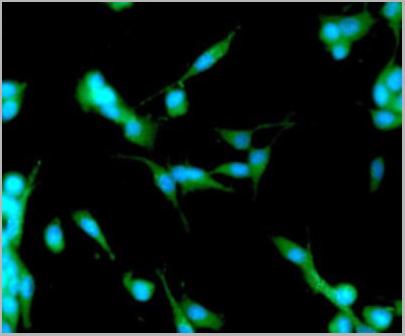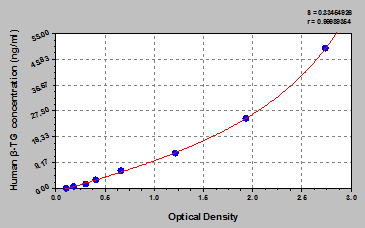Rabbit beta Amyloid Polyclonal Antibody | anti-APP antibody
Anti-beta Amyloid Antibody
Immunohistochemistry-Paraffin (IHC-p): Concentration: 0.5-1ug/ml ; Tested Species: Mouse, Rat ; Predicted Species: Human ; Antigen Retrieval: By heat
Immunohistochemistry-Frozen Section (IHC-Fr): Concentration: 0.5-1ug/mL ; Tested Species: Human
Immunocytochemistry / Immunofluorescence (ICC/IF): Concentration: 2ug/ml ; Tested Species: Human
Flow Cytometry: Concentration: 1-3ug/1X106 cells ; Tested Species: Human
WB: The detection limit for beta Amyloid is approximately 0.25ng/lane reducing conditions.
Tested Species: In-house tested species with positive results.
Predicted Species: Species predicted to be fit for the product based on sequence similarities.
By Heat: Boiling the paraffin sections in 10mM citrate buffer , pH 6.0 , for 20mins is required for that staining of formalin/paraffin sections.
Other applications have not been tested.
Optimal dilutions should be determined by end users.
FCM (Flow Cytometry)
(Figure 6. Flow Cytometry analysis of PC-3 cells using anti-APP antibody (AAA11597).Overlay histogram showing PC-3 cells stained with AAA11597 (Blue line).The cells were blocked with 10% normal goat serum. And then incubated with rabbit anti-APP Antibody (AAA11597,1ug/1x10^6 cells) for 30 min at 20 degree C. DyLight®488 conjugated goat anti-rabbit IgG (5-10ug/1x10^6 cells) was used as secondary antibody for 30 minutes at 20 degree C. Isotype control antibody (Green line) was rabbit IgG (1ug/1x106) used under the same conditions. Unlabelled sample (Red line) was also used as a control.)
FCM (Flow Cytometry)
(Figure 5. Flow Cytometry analysis of SIHa cells using anti-APP antibody (AAA11597).Overlay histogram showing SIHa cells stained with AAA11597 (Blue line).The cells were blocked with 10% normal goat serum. And then incubated with rabbit anti-APP Antibody (AAA11597,1ug/1x10^6 cells) for 30 min at 20 degree C. DyLight®488 conjugated goat anti-rabbit IgG (5-10ug/1x10^6 cells) was used as secondary antibody for 30 minutes at 20 degree C. Isotype control antibody (Green line) was rabbit IgG (1ug/1x106) used under the same conditions. Unlabelled sample (Red line) was also used as a control.)
IHC (Immunohistochemistry)
(Figure 4. IHC analysis of beta Amyloid using anti-beta Amyloid antibody (AAA11597). beta Amyloid was detected in paraffin-embedded section of mouse brain tissues. Heat mediated antigen retrieval was performed in citrate buffer (pH6, epitope retrieval solution) for 20 mins. The tissue section was blocked with 10% goat serum. The tissue section was then incubated with 1ug/ml rabbit anti-beta Amyloid Antibody (AAA11597) overnight at 4 degree C. Biotinylated goat anti-rabbit IgG was used as secondary antibody and incubated for 30 minutes at 37 degree C. The tissue section was developed using Strepavidin-Biotin-Complex (SABC) with DAB as the chromogen.)
IHC (Immunohistochemistry)
(Figure 3. IHC analysis of beta Amyloid using anti-beta Amyloid antibody (AAA11597). beta Amyloid was detected in paraffin-embedded section of rat brain tissues. Heat mediated antigen retrieval was performed in citrate buffer (pH6, epitope retrieval solution) for 20 mins. The tissue section was blocked with 10% goat serum. The tissue section was then incubated with 1ug/ml rabbit anti-beta Amyloid Antibody (AAA11597) overnight at 4 degree C. Biotinylated goat anti-rabbit IgG was used as secondary antibody and incubated for 30 minutes at 37 degree C. The tissue section was developed using Strepavidin-Biotin-Complex (SABC) with DAB as the chromogen.)
WB (Western Blot)
(Figure 2. Western blot analysis of beta Amyloid using anti-beta Amyloid antibody (AAA11597). Electrophoresis was performed on a 5-20% SDS-PAGE gel at 70V (Stacking gel) / 90V (Resolving gel) for 2-3 hours. The sample well of each lane was loaded with 50ug of sample under reducing conditions. lane 1: rat brain tissue lysate, lane 2: mouse brain tissue lysate. After Electrophoresis, proteins were transferred to a Nitrocellulose membrane at 150mA for 50-90 minutes. Blocked the membrane with 5% Non-fat Milk/ TBS for 1.5 hour at RT. The membrane was incubated with rabbit anti-beta Amyloid antigen affinity purified polyclonal antibody at 0.5ug/mL overnight at 4 degree C, then washed with TBS-0.1%Tween 3 times with 5 minutes each and probed with a goat anti-rabbit IgG-HRP secondary antibody at a dilution of 1:10000 for 1.5 hour at RT. The signal is developed using an Enhanced Chemiluminescent detection (ECL) kit with Tanon 5200 system. A specific band was detected for beta Amyloid at approximately 87KD. The expected band size for beta Amyloid is at 87KD.)
WB (Western Blot)
(Figure 1. Western blot analysis of beta Amyloid using anti-beta Amyloid antibody (AAA11597). Electrophoresis was performed on a 5-20% SDS-PAGE gel at 70V (Stacking gel) / 90V (Resolving gel) for 2-3 hours. lane 1: recombinant human beta-Amyloid protein 0.5ng. After Electrophoresis, proteins were transferred to a Nitrocellulose membrane at 150mA for 50-90 minutes. Blocked the membrane with 5% Non-fat Milk/ TBS for 1.5 hour at RT. The membrane was incubated with rabbit anti-beta Amyloid antigen affinity purified polyclonal antibody at 0.5ug/mL overnight at 4 degree C, then washed with TBS-0.1%Tween 3 times with 5 minutes each and probed with a goat anti-rabbit IgG-HRP secondary antibody at a dilution of 1:10000 for 1.5 hour at RT. The signal is developed using an Enhanced Chemiluminescent detection (ECL) kit with Tanon 5200 system. A specific band was detected for beta Amyloid at approximately 29KD. The expected band size for beta Amyloid is at 29KD.)
Background: beta Amyloid, also called Abeta or Abeta, denotes peptides of 36-43 amino acidsthat are crucially involved in Alzheimer's disease as the main component of the amyloid plaques found in the brains of Alzheimer patients. It is mapped to 19q13.12. Several potential activities have been discovered for beta Amyloid, including activation of kinase enzymes, functioning as atranscription factor, and anti-microbial activity (potentially associated with beta Amyloid's pro-inflammatoryactivity). Moreover, monomeric beta Amyloid is indicated to protect neurons by quenching metal-inducible oxygen radical generation and thereby inhibiting neurotoxicity.
NCBI and Uniprot Product Information
Similar Products
Product Notes
The APP app (Catalog #AAA11597) is an Antibody produced from Rabbit and is intended for research purposes only. The product is available for immediate purchase. The Anti-beta Amyloid Antibody reacts with Human, Mouse, Rat and may cross-react with other species as described in the data sheet. AAA Biotech's beta Amyloid can be used in a range of immunoassay formats including, but not limited to, WB (Western Blot), IHC (Immunohistochemistry). Western Blot : Concentration: 0.1-0.5ug/mL ; Tested Species: Human, Mouse, Rat Immunohistochemistry-Paraffin (IHC-p): Concentration: 0.5-1ug/ml ; Tested Species: Mouse, Rat ; Predicted Species: Human ; Antigen Retrieval: By heat Immunohistochemistry-Frozen Section (IHC-Fr): Concentration: 0.5-1ug/mL ; Tested Species: Human Immunocytochemistry / Immunofluorescence (ICC/IF): Concentration: 2ug/ml ; Tested Species: Human Flow Cytometry: Concentration: 1-3ug/1X106 cells ; Tested Species: Human WB: The detection limit for beta Amyloid is approximately 0.25ng/lane reducing conditions. Tested Species: In-house tested species with positive results. Predicted Species: Species predicted to be fit for the product based on sequence similarities. By Heat: Boiling the paraffin sections in 10mM citrate buffer, pH 6.0, for 20mins is required for that staining of formalin/paraffin sections. Other applications have not been tested. Optimal dilutions should be determined by end users. Researchers should empirically determine the suitability of the APP app for an application not listed in the data sheet. Researchers commonly develop new applications and it is an integral, important part of the investigative research process. It is sometimes possible for the material contained within the vial of "beta Amyloid, Polyclonal Antibody" to become dispersed throughout the inside of the vial, particularly around the seal of said vial, during shipment and storage. We always suggest centrifuging these vials to consolidate all of the liquid away from the lid and to the bottom of the vial prior to opening. Please be advised that certain products may require dry ice for shipping and that, if this is the case, an additional dry ice fee may also be required.Precautions
All products in the AAA Biotech catalog are strictly for research-use only, and are absolutely not suitable for use in any sort of medical, therapeutic, prophylactic, in-vivo, or diagnostic capacity. By purchasing a product from AAA Biotech, you are explicitly certifying that said products will be properly tested and used in line with industry standard. AAA Biotech and its authorized distribution partners reserve the right to refuse to fulfill any order if we have any indication that a purchaser may be intending to use a product outside of our accepted criteria.Disclaimer
Though we do strive to guarantee the information represented in this datasheet, AAA Biotech cannot be held responsible for any oversights or imprecisions. AAA Biotech reserves the right to adjust any aspect of this datasheet at any time and without notice. It is the responsibility of the customer to inform AAA Biotech of any product performance issues observed or experienced within 30 days of receipt of said product. To see additional details on this or any of our other policies, please see our Terms & Conditions page.Item has been added to Shopping Cart
If you are ready to order, navigate to Shopping Cart and get ready to checkout.
























